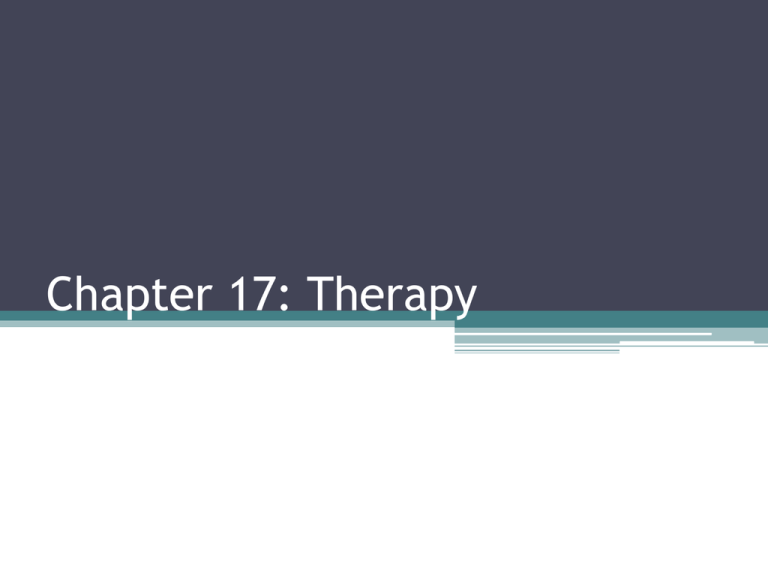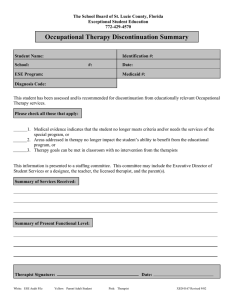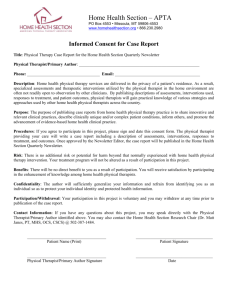Chapter 17: Therapy
advertisement

Chapter 17: Therapy While focusing on several intrusive thoughts that had been bothering her recently, Jenny was instructed by her therapist to report any ideas or memories stimulated by these thoughts. Jenny’s therapist was making use of a technique known as: A. B. C. D. active listening. free association. systematic desensitization. transference. Humanistic therapies differ from psychoanalytic therapies in all of the following ways, EXCEPT: A. psychoanalytic therapists are more likely to encourage the client to take immediate responsibility for feelings. B. humanistic therapists are more oriented to the present and future, rather than the past. C. psychoanalytic therapists are more likely to emphasize unconscious processes. D. humanistic therapists are more growth-oriented. McKenzie’s therapist believes that active listening is an extremely important component of therapy. He is probably a: A. B. C. D. psychoanalyst. cognitive therapist. behavior therapist. client-centered therapist. Client-centered therapists emphasize the importance of: A. exploring clients’ childhood relationships with other family members. B. interpreting the meaning of clients’ nonverbal behaviors. C. enabling clients to feel unconditionally accepted. D. helping clients identify a hierarchy of anxietyarousing experiences. A therapist helps Rebecca overcome her fear of water by getting her to swim in the family’s backyard pool three times a day for two consecutive weeks. The therapist’s approach to helping Rebecca best illustrates: A. B. C. D. stress inoculation training. aversive conditioning. exposure therapy. humanistic therapy. A cognitive therapist would be most likely to say: A. “That sounds quite frustrating. It isn’t easy to be in a situation like that.” B. “Can you think of a more positive interpretation of what happened?” C. “Just say whatever comes to mind, no matter how trivial or irrelevant it might seem.” D. “Next time you start to feel anxious, you can use the relaxation techniques we’ve been working on.” For which of the following disorders is psychotherapy most likely to be effective in the long run? A. B. C. D. generalized anxiety disorder major depressive disorder chronic schizophrenia phobias Researchers have sought to answer the question, “Does psychotherapy work?” Generally speaking, the answer seems to be: A. yes, people in therapy improve more than people in control groups. B. yes, but people in therapy improve at the same rate as people who are receiving placebo treatments. C. no, therapy does not provide any benefits; people who just let time pass improve at the same rate as people in therapy. D. no one really knows, because so far the only method used to answer this question has been interviewing former therapy clients. The effectiveness of psychotherapy shows little if any connection to: A. the level of training and experience of the therapist. B. the length of time a client has experienced symptoms of disorder prior to therapy. C. the particular disorder experienced by a client. D. the extent to which the process depends on changing clients’ personalities. The placebo effect best illustrates the importance of _______ in therapeutic success. A. B. C. D. active listening psychopharmacology behavior modification cognitive processes Critical Thinking Questions If a therapist tells a client, “Rank order the things that frighten you from least to most,” the therapist is most likely practicing: A. B. C. D. Freudian therapy. systematic desensitization. Gestalt therapy. token economy. Jon’s therapist laces his alcoholic drink with a drug that makes Jon sick. After getting sick a few times, just the sight of the drink makes Jon nauseous. In this example, the conditioned stimulus is the: A. B. C. D. drug. alcohol. nauseous response to the drug. nauseous response to the sight of the drink. Your therapist asks you to try to remember your dreams. He also encourages you to review incidents in early childhood. Your therapist is most likely practicing: A. B. C. D. Freudian therapy. cognitive therapy. behavior therapy. humanistic therapy. In your therapy session you often review your current behaviors as compared to what you think you should be doing. Your therapist is kind and listens to your ideas, even if you think they are silly. Your therapist is most likely practicing: A. B. C. D. Freudian therapy. Jungian therapy. cognitive therapy. humanistic therapy. Samuel receives some very bad news, and feels quite low. As time passes, you would expect: A. his emotions to return to their usual state. B. his emotions to stay low until something unusually good happens to him. C. him to become much happier than usual, since people typically bounce back and forth between emotional extremes. D. him to stay emotionally low unless he goes in for psychotherapy.







